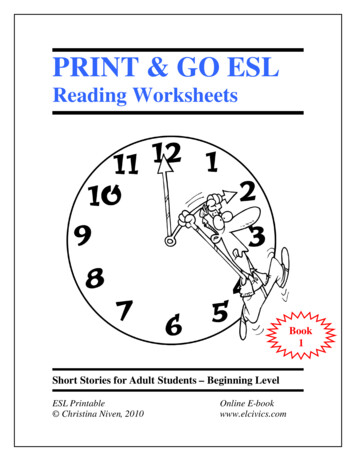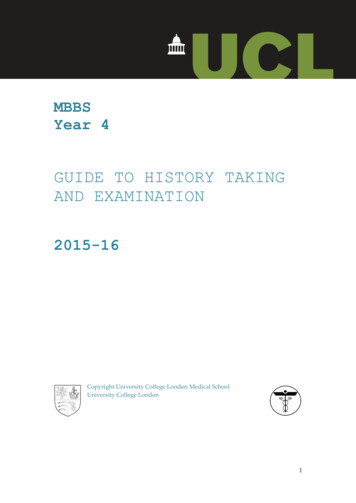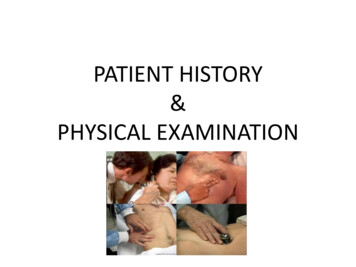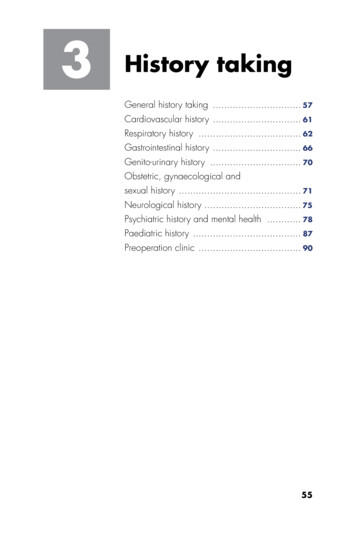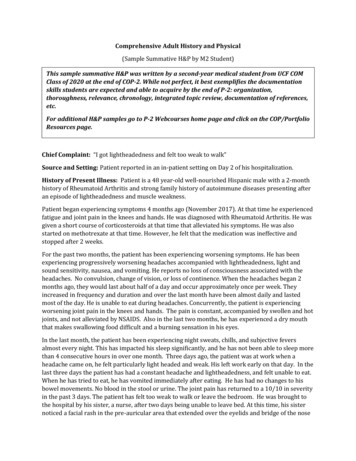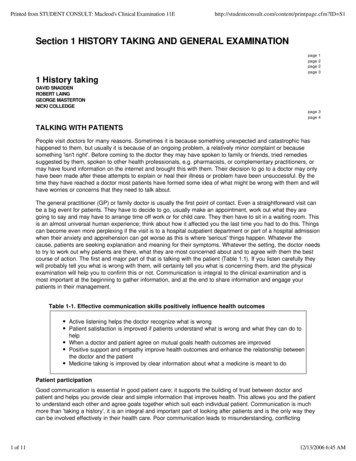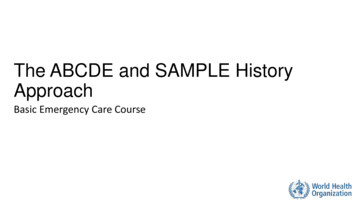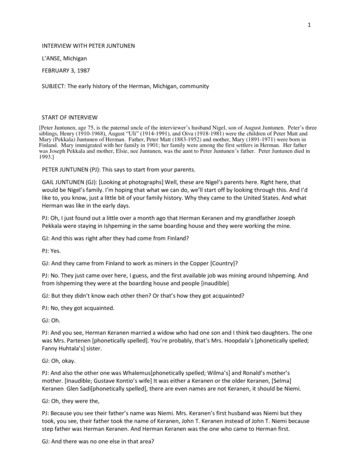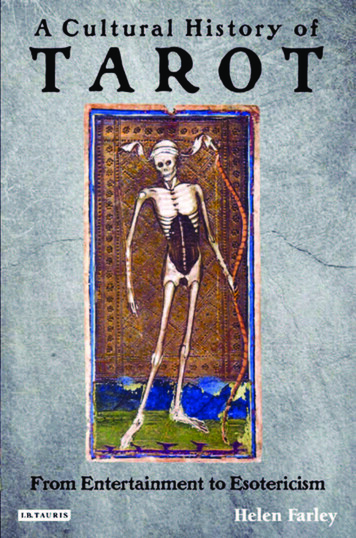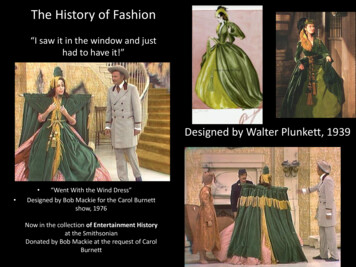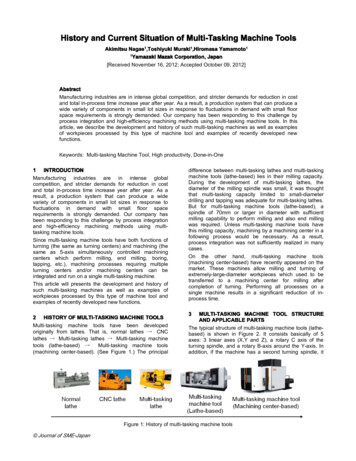
Transcription
History, Civics&Geography (HCG) History and Civics Geography
History and CivicsCore concepts of History and Civics for Class VII are as under:Class VIIThe Medieval WorldMedieval Europe – Rise and Spread of ChristianityRise and Spread of IslamThe Delhi SultanateThe Mughal EmpireCivicsThe Constitution of IndiaDirective Principles of State Policy1
The Medieval WorldTheme 1: Medieval Europe – Rise and Spread of Christianity‘Medieval Europe – Rise and Spread of Christianity’ aims at exposing and providing childreninformation to be able to understand the transition of Europe from the Ancient RomanEmpire to the Medieval Byzantium Empire. The rise and spread of Christianity will broadentheir perspective on beliefs over the globe. In these days of globalized lifestyle, this iscritical for developing an in depth understanding about the rise of religion.Learning outcomes:Children will be able to:trace the origin and spread of Christianity;reflect on the basic principles and teachings of Christianity;identify similarities of the good teachings of the various forms of Religion;discuss and analyse the relevance of Christ’s teachings in the present day context;analyse the relationship between the decline of the Roman empire and the spread of Christianity;study the impact of crusades in Europe;analyse the influence of the church on the life of people in Europe.Medieval Europe – Rise and Spread of ChristianityKey Concepts /Concerns Meaningof‘Medieval’,theSuggested ievalperiod in the world andIndiaonthe Mindbasis ofevidences. Socio/politicalcircumstances. Birth of Christianity. Roman conquest ofPalestine. Main Teachings of Jesus. Role of EmperorConstantine in spreadingChristianity. Emergenceof Constantinople as a newChristian Capital.Medieval Europe.Decline of the AncientRoman Empire.Byzantium: birth of a newempire. mapping on the society inmedieval Europe and the circumstancesthat led to the rise of Christianity.Organising discussions with childrenon: sharing their previous knowledge (ifany) about Christianity. appreciating the good teachings thatvarious religions offer. constructing a time line on the riseand spread of the Roman Empire. analysing the reasons and impact ofthe Barbarian and Byzantiuminvasions. explaining the meaning and theimpact of crusades.Showing Audio Visual aids on: practices in Christianity – Crusadesand Sacred journeys. suggested film – Greatest Story evertold as a movie experience.Enactment of scenes by children fromJesus’s life through role plays / skits.Conducting activities related to: celebrating of Christmas in School.2Suggested LearningResources Related films, videos anddocumentaries. Role play Mind mapping Flowcharts Quizzes Children’s illustrated Bibleand Encyclopaedia. PPTs. Outline map of the world Newspapers Clippings andarticles.
Medieval Europe – Rise and Spread of ChristianityKey Concepts /ConcernsSuggested TransactionalProcesses Emergence of the Turks and organising ‘a day of Selfless Service’the Crusades. in school. designing web charts and flow charts(individually and in groups) on therise and spread of Christianity. class presentations on the commonfeatures of religions. Flow chart of chronology of eventsCreating an imaginary role of a monkor nun living in a monastery during themedieval period – writing an account ofyour daily routine.Showing the routes on an outline mapof the world taken by crusaders andmark countries where Christianity isthe official religion.3Suggested LearningResources
Theme 2: Rise and Spread of IslamThe theme ‘Rise and Spread of Islam’ aims at enabling children to understand a majorturning point in the history of mankind with the emergence of a new faith that spreadacross many continents and affected the politics, life and culture of many places. Thesuggested pedagogies will help children appreciate the ‘welfare of mankind’ as the basisof all religions.Learning outcomes:Children will be able to:trace the emergence and spread of Islam in Saudi Arabia;discuss the basic principles and teachings of Islam;report on observations related to some other beliefs and practices;appreciate a humanitarian approach as the basis of all religions.Rise and Spread of IslamKey Concepts /Concerns Birth of Prophet MohammadEarly life teachings and fivebasic principles of IslamSpread of Islam Suggested TransactionalProcessesOrganising discussions on:the similarities in thebasic teachings and principles of allthe religions. inculcating a sense of compassion,empathy and welfare amonghumans that forms the basis of allreligions.Showing documentaries on -the Cityof Mecca and Medina, Haj, Eidcelebrations. This will be followed bydiscussions.Narrating / reading stories from“illustrated Quran Stories’, followed bydiscussions. appreciating4Suggested LearningResources Timeline Mind mapping Films and documentaries. Related videos and PPTs Books, magazines and encyclopaediasFlash cards – Pillars ofIslam – Words, Symbolsand actions
Theme 3: The Delhi Sultanate‘The Delhi Sultanate’ will provide children an insight and enable them to understand thetimes of the Sultans of Delhi. Interesting pedagogy motivates children to discuss, explore,compare and analyse the information on this period and relate it to present day life. Itwill help children understand how the past has shaped the present.Learning outcomes:Children will be able to:discuss the emergence of Delhi as a seat of power;name the five dynasties that ruled Delhi;analyse the influence and impact of notable rulers on the Sultanate.The Delhi SultanateKey Concepts /Concerns The Turkish invasionsThe rule of the five dynastiesof Delhi Sultanate period, theSuggested TransactionalProcesses Organising discussions with children Charts, Maps Flowcharton: interpreting the meaning of Related Videos, films,important rulers and their-Iltutmish, Ghiyasuddin Balban; Khilji Dynasty - AlauddinKhilji; Tuglaq dynasty Mohammand bin Tuglaq.“Sultanate”.the reasons and theimpact of invasions.Showing Audio visuals on: the Impact of the Sultanate period the invasions of Mahmud of Ghaziniand his plunder of temples. “Bharat ek Khoj’. the Episodes on the rulers of DelhiSultanate.Making a Flow chart activity onSultans of DelhiRole plays/skits on: the failed experiments ofMuhammad bin Tughlaq. an actual transfer of Class tocomprehendMuhammadbinTughlaq’s transfer of capital. creating a simulation of markets inthe Khilji dynasty and designingmarket policies.Organizing a debate on the views ofhistorians on Muhammad bin Tughlaq(wisest fool/way ahead of his time)Written Assignments may include: designing a Delhi SultanateNewspaper creating a royal officials account inGhiyasuddin Balban’s Court – analysingsignificance (briefly): Mamluk / Slave DynastySuggested LearningResources 5 documentaries and slideshows.Written expressionBooks, Comics,Encyclopedias and plays(Tughluq).Illustrations made bylearners.Bulletin Board.Puppets.Coins, Costumes – imagesor actual.
The Delhi SultanateKey Concepts /ConcernsSuggested TransactionalProcesses Giving an account of theirobservations of the usual day to dayproceedings in the Royal court. timeline exercise on the Sultans ofDelhi.Conducting Activities relating to: narrating events based on the DelhiSultanate. reading excerpts from the play“Tughlaq” by Girish Karnad designing a class bulletin board onthe Monuments of the DelhiSultanate. writing a historian’s account of anyone of the policies introduced in theDelhi Sultanate and the impact itcaused.Preparing a case study on expansionofempire,administration,significance of court, nobility and landcontrol of any of the rulers mentionedabove.6Suggested LearningResources
Theme 4: The Mughal EmpireThe theme will expose children to the Mughal Empire and enable them to understand whyand how it became the most important Empire of the later period of Medieval IndianHistory. The Empire stretched over a vast territory of the Indian subcontinent and hada rich diversity of people and cultures. Children will also appreciate the Mughal Art andArchitecture which forms a rich heritage of India.Learning outcomes:Children will be able to:trace the emergence of the Mughal dynasty in India;identify the factors that led to the conquest of India by Babur;analyse the achievements and failures of Mughal emperors;discuss and appreciate the administration, foreign policy, relation with regional kings andDin-e-Illahi of Akbar;evaluate the influence of the legacy this period left behind;understand the rise of regional powers posing a threat to the Mughal empire.The Mughal EmpireKey Concepts /ConcernsSuggested TransactionalProcessesSuggested LearningResources An Overview of the Mughal Organising discussions on: InteractionsEmpire. the origin of the Mughals. Pictures of Mughal era. The first battle of Panipat difference in the origin of the Mughals Videos and films.and establishment ofand the rulers of the Delhi Sultanate. Illustrations made by theMughal Empire.learner. analysing the reasons 0f defeat of BaburIbrahim Lodi in the first battle of Games designed bychildren. Akbar: a case study ofPanipat and the establishment ofAkbar and his times.Mughal Empire. Books and(relation with other rulers,encyclopaedia’s Akbar’s policy towards Indian rulersadministrator, revenuewith special reference of the Rajputs Creating a Mughalsystem, religious policy).and Din-E-Illahinewspaper Aurangzeb and his Deccan political developments and military Pictorial depictionspolicy.conquests during the times of Akbar Diary recordingand Aurangzeb. Decline of Mughal Empire Quizzes. the varieties of monumental Web chart, flow charts architecture, range of materials, skilland styles used and resources requiredfor building works.Conducting Audio Visual shows on theMughal rulers and their achievementsNarrating stories of this period throughprinted / published material that is ageappropriate.Enactment of Role Plays by children on: a simulation of Diwan-i-aam, wherethe class resolves their issues. Akbar Birbal stories. any one ruler of the Mughal dynasty7
The Mughal EmpireKey Concepts /ConcernsSuggested TransactionalProcesses Ad- acting on the rich legacy of theMughal era – art, culture, language,jewellery, dresses, etc.Written assignments may include: launching a Newspaper based onevents of the Mughal era. devising Web charts and flow charts assembling a ‘Recipe book of MughalCuisine.Creating a Newspaper Ad- Gamesinviting membership to Designing BoardGames Din – I - Ilahi. achievement of rulers. a diary recording of Shahjahan whenimprisoned in the Agra Fort.Integration: Arts Education8Suggested LearningResources
Theme 1: The Constitution of IndiaThe theme ‘The Constitution of India’ aims at providing information and an insight tochildren into the supreme law of India containing fundamental rules governing its politicsand society as a whole. Children will also be able to discuss and understand the need fora Constitution. This understanding is necessary for them to grow into responsible citizensin a secular democracy.Learning outcomes:Children will be able to:infer and illustrate the idea of a Constitution and its purpose;discuss the role of the Constituent Assembly;understand the preamble, its aims and objectives;appreciate the contribution of great Indian thinkers in framing the Constitution of India.The Constitution of IndiaKey Concepts /Concerns The Constitution – itsSuggested TransactionalProcesses Organising discussions on: meaning and purpose. The role of the ConstituentAssembly. The Preamble, its aims andobjectives. the meaning of Constitution.purpose of a Constitutionthe important elements of thePreamble the ideas of the IndianConstitution the role of prominent membersof the Constituent assemblyConducting Audio Visual shows on: the Documentary - Tryst withDestiny the making of India’sConstitution Part 1 -2. making of the Constitution – Indian Pride: Making of theIndian Constitution.9Suggested LearningResources A copy of the IndianConstitution.Videos and Films.Experts/Judge/Advocate
Theme 2: Directive Principles of State Policy‘Directive Principles of State Policy’ will enable children to understand the principles thatdirects the state to create opportunities for the welfare of all citizens. The understandingin turn will help them grow as sensitive, deliberative, responsible and transformativecitizens.Learning outcomes:Children will be able to:discuss the meaning of the Directive Principles of State Policy;examine the features of a welfare state;assess the importance of the directive principles;analyse the welfare activities by various kings in Indian history;compare the welfare activities in the past with today’s welfare activities.Directive Principles of State PolicyKey Concepts /ConcernsSuggested TransactionalProcesses Welfare State – Features. Organising discussions on: Directive Principles of State the reasons for a welfare state. rulers in history who believed in andPolicy – Meaning andImportancecreated welfare states.comparison of a welfare state ofprevious times with today’s welfarestate.Conducting a Debate on the DirectivePrinciples of State Policy – A Dream ora reality.Audio Visuals: short documentaries on initiativesstarted by Government. building toilets removal of child labour. promotion of cottage Industries.Enactment of Role plays by childrenon: An Effective Village Panchayat’ whocan resolve daily problems of villagersand help towards establishing a welfarestate.Written Assignments may include: writing a letter to the DM givingsuggestions for fixing the streetlights in your area. The ‘welfare school’ planPreparing a project report byindividual or groups of children basedon a survey/ research conducted onlocal craftsman and the help providedby the government / NGOs to them. a 10Suggested LearningResources Discussions/Debate News Paper articles Magazine article
“illustrated Quran Stories’, followed by discussions. Timeline Mind mapping Films and documentaries. Related videos and PPTs Books, magazines and encyclopaedias Flash cards – Pillars of Islam – Words, Symbols and actions. 5 . Theme 3: The Delhi Sultanate ‘T. he Delhi Sultanate’ will provide children an insight and enable them to understand the times of the Sultans of Delhi .
